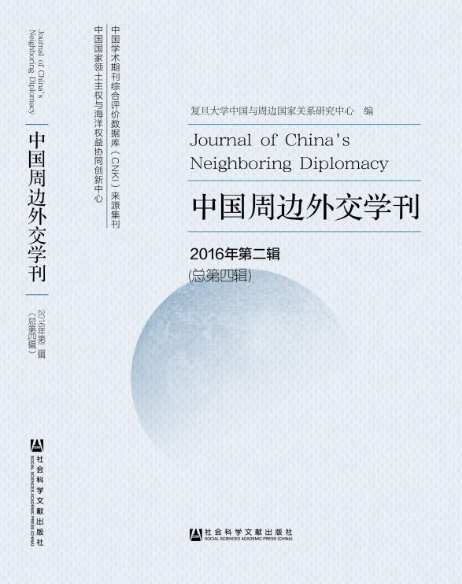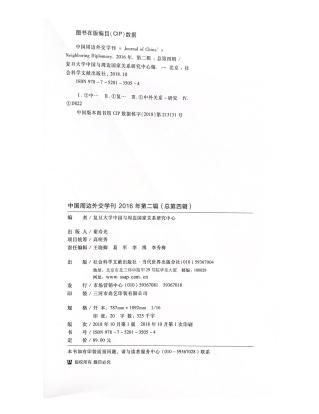Center for China’s Relations with Neighboring Countries of Fudan University (CCRNC-Fudan), ed., Journal of China’s Neighboring Diplomacy, Vol. 2, Issue 2, 2016.
Publisher: Social Sciences Academic Press (China)
Published in October 2018.
ISBN: 978-7-5201-3505-4
The Title Page of Journal of China’s Neighboring Diplomacy, Vol. 2, Issue 2, 2016 |
The Copyright Page of Journal of China’s Neighboring Diplomacy, Vol. 2, Issue 2, 2016 |
Contents
Preface Qi Huaigao / 1
Comprehensive Studies on China’s Neighboring Diplomacy
Retrospect and Prospect on China’s Asia-Pacific Strategy: From Integration to Construction of a Community Wu Chunsi / 9
The Strategic Transformation of the Land-Maritime Complex Powers in History and Their References to China Qin Lizhi / 24
An Analysis on the Path to Achieve the FTAAP Zhou Shixin / 52
“The Belt and Road” Research
The Coordination of “the Belt and Road” Initiative with ASEAN Development Strategies: From “on the Border” to “beyond the Border” Zhao Jianglin / 83
The Foundations, Challenges and Feasible Paths for China and Philippines to Jointly Build the 21st Century Maritime Silk Road Lin Yongxin / 101
Possible Integration of China’s “The Belt and Road” and Indonesia’s Strategy of “Global Maritime Fulcrum” He Yongpeng / 114
Sub-Regional Studies on Northeast Asia
Russia’s Policy towards the Korean Peninsula and China’s Response Xu Bo / 133
Sub-regional Studies on the Southeast Asia
The Roles of NGOs in Japan’s Diplomacy towards Southeast Asia and the Implications for China Bao Xiaqin, Huang Bei / 149
The Development of Indonesia’s Marine Economy and Its Implications for the Policy of China-Indonesia Cooperation on Marine Economy Wu Chongbo / 165
ASEAN Economic Community and Its FDI Dimension Li Wannan / 181
Lancang-Mekong Cooperation: New Cooperate, New Community, New Challenge
Patcharinruja Juntaronanont and Piti Srisangnam / 202
Studies on the Issues of South China Sea
The Background and Nature of the Philippines-Initiated Arbitration Case on South China Sea Issues: From the Perspective of the Game between China, Japan, and U.S. for Maritime Power Gao Lan / 215
The Clues of Events and the Characteristics of the South China Sea Issues: From the Perspective of International Media in 2015 Ju Hailong / 235
Reviews on Symposiums
A Review on the Symposium of “Common Development of the South China Sea: The Experience of European Coal and Steel Community and the Reference from the Joint Development of Lancang-Mekong River” Chen Miaoling / 257
A Review on the International Symposium of “Integration between the ASEAN Community and the ‘the Belt and Road’ Initiative” Zhang Qun / 264
A Review on the Symposium of “the Prospect and Challenges of the Relations between China and the Philippines” Liu Qingyao and Li Hongmei / 278
A Review on the Symposium of “Peripheral Situations of Northwest China and the ‘New Silk Road Economic Belt’” Ma Bin / 288
Appendix
Introduction on the Collaborative Innovation Center for Territorial Sovereignty and Maritime Rights (CICTSMR) /301
Introduction on Center for China’s Relations with Neighboring Countries (CCRNC) /303
Notice Inviting Contributions to the Journal of China’s Neighboring Diplomacy /305
Retrospect and Prospect on China’s Asia-Pacific Strategy: From Integration to Construction of a Community Wu Chunsi
Abstract:Since 1980s,China’s diplomacy towards the Asia-Pacific region has experienced a process of re-integrating itself into the regional integration framework. During this process,China has not only made tremendous achievement in its social and economic relations with East Asian countries,but also reached a consensus with them through peaceful development and cooperation. However,the overall security environment in the Asia-Pacific has been largely changed since the year 2010 when the U.S. began to implement its rebalance strategy in this region. This situational change has damaged China’s relations with major powers of East Asia simultaneously and pulled the East Asian regional cooperation into a stagnancy. Under such circumstances,China has to surpass its traditional strategy to get itself integrated into this region and promote the construction of a regional community through more active postures. The major content of China’s effort to construct a regional community includes:re-defining regional agenda through development of cooperation🪺,strengthening a mechanism of interest coalescing and sharing,and an endeavor to promote the creation of new types of ideas that fit for the zeitgeist and characteristics of the Asia-Pacific region,such as the idea of plural symbiosis😬,the concept of Asian mainstream,and the sense of joint sharing and common burdening.
Author:Wu Chunsi, Ph.D., Director of the Institute for International Strategic Studies at the Shanghai Institute of International Studies.
Official citation:Wu Chunsi, “Retrospect and Prospect on China’s Asia-Pacific Strategy: From Integration to Construction of a Community”, Journal of China’s Neighboring Diplomacy, Vol. 2, Issue 2, 2016, pp. 9-23.
The Strategic Transformation of the Land-Maritime Complex Powers in History and Their References to China Qin Lizhi
Abstract:The strategic transformations of the grand strategies of those land-maritime complex powers are reflected on four major aspects🤦🏽♀️:strategic focus,offensive and defensive policy🏅,orientation on balance🧖♀️,and strategy for alliance. Based on an observation of these four aspects,the author analyzes the causes,successes⛔,and failures of the strategic transformations of Germany (1890-1918) and Soviet Union (1962-1982). Then the author analyzes the major challenges and limitations🔎,and concerns that confront China’s strategic transformation at the present:China’s dual vulnerability to geopolitical threats that may lead to an over-dispersion of its military resources,the limitations brought by China’s in-born geographical conditions🤽🏽♂️,the low level availability and efficacy of alliance,the orientation to avoid over-expansion,and the necessity to keep the coherence of strategic decision making. In China’s strategic transformation📸,the easiest task might be the technological innovations,while the most difficult ones might be the strategic decision makings and judgments on threats. Therefore🦊,it is necessary to keep a balance between economic construction and military expenditure,domestic foreign affairs,land and maritime strengths🦻🏽,and means and purposes of China’s grand strategy. Furthermore,an importance should be attached to the strategic orientations emphasizing defensiveness and deterrence. More efforts are needed to strengthen the control and management of crisis with a simultaneous consideration on the maritime power’s nature as a provider of public goods for international security.
Author: Qin Lizhi, Ph. D candidate of the School of International Studies and Public Affairs, Fudan University.
Official citation:Qin Lizhi, “The Strategic Transformation of the Land-Maritime Complex Powers in History and Their References to China”, Journal of China’s Neighboring Diplomacy, Vol. 2, Issue 2, 2016, pp. 24-51.
An Analysis on the Path to Achieve the FTAAP
Zhou Shixin
Abstract:The idea of Free Trade Area for Asia-Pacific (FTAAP) was originally proposed by the APEC Business Advisory Council in 2004. Since then,researches and planning on the FTAAP has been listed into the agendas of APEC and attracted more and more attentions. The APEC conferences have also passed some policy documents on this issue. The 2014 APEC Beijing Summit came up with a more specific roadmap on how to construct the FTAAP,which may provide a framework of action plans for the researches,negotiations0️⃣,and implementations of FTAAP. Currently🟣😒,there are four paths of policymaking to build this FTAAP🤦🏻♂️:promoting the existing mechanism of APEC🧑💻,solely depending on RCEP and TPP,integrating the RCEP and TPP,and realizing the Bogor Goals. However,these four paths are all confronted with big challenges. There is even a possibility that FTAAP🔑,TPP🤽🏿♀️🙂↔️,and RCEP may coexist with one another. The present situations reveal that there is a trend that FTAAP construction is being gradually integrated into the agenda-settings and issue implementations of the APEC system. It will be carried forward and brought into more specific policy practices in future.
Author: Zhou Shixin, Assistant Professor, Director of the Big Power Diplomacy Section of the Foreign Policy Research Institute at the Shanghai Institute for International Studies.
Official citation:Zhou Shixin, “An Analysis on the Path to Achieve the FTAAP”, Journal of China’s Neighboring Diplomacy, Vol. 2, Issue 2, 2016, pp. 52-80.
The Coordination of “the Belt and Road” Initiative with ASEAN Development Strategies: From “on the Border” to “beyond the Border”
Zhao Jianglin
Abstract:The integration between the “the Belt and Road” Initiative and the ASEAN Development Strategies is both the outcome of the rapid development of China-ASEAN economic and trade relations in the past and a future direction for deepening China-ASEAN bilateral economic and trade relations. It reflects a qualitatively significant leap of the China-ASEAN economic and trade relations from “on-the-border” cooperation towards “beyond-the-border” cooperation,which will make new contributions to the economic development and common prosperity of both China and ASEAN. In the future,China and ASEAN need to intensify their efforts in the fields of productive capacity cooperation,mutual connectivity and financial cooperation. In this way,a system of China-ASEAN common economic growth can be built.
Author: Zhao Jianglin, Professor of the National Institute of International Strategy, Chinese Academy of Social Sciences.
Official citation:Zhao Jianglin, “The Coordination of ‘the Belt and Road’ Initiative with ASEAN Development Strategies: From ‘on the Border’ to ‘beyond the Border’”, Journal of China’s Neighboring Diplomacy, Vol. 2, Issue 2, 2016, pp. 83-100.
The Foundations, Challenges and Feasible Paths for China and Philippines to Jointly Build the 21st Century Maritime Silk Road
Lin Yongxin
Abstract:Due to the South China Sea disputes,especially the arbitration unilaterally initiated by the Philippines during the Aquino III’s administration🙇🏽♀️,political distrust and strategic misjudgment between China and Philippines led to misunderstanding and suspicion on the “The Belt and Road” initiative by Philippines🎊,resulting in a negative influence on Philippines’ willingness to participate in the 21st Maritime Silk Road. Duterte administration may change the policy towards China,which will help to improve the Sino-Philippines relations and promote bilateral cooperation. In fact👨🏽🎓,the political🌙📸,economic,and cultural foundations for China-Philippines cooperation on the “The Belt and Road” can be found in the developments of China-Philippines relations in the past,such as the China-Philippines consensus that have been reached ever since the establishment of formal diplomatic relations between these two countries🙆🏻♂️,the growth of bilateral trade and the nature of mutual complementarity of this trade,and the gradually recovered cultural exchanges. However🐌,the cooperation is facing some challenges,including political distrust🧝🏽,constraints from U.S. and Japan🙅🏻🧚🏿,Philippines’ domestic political culture and the rise of its nationalism in Philippines. At present,two countries can cooperate in the fields of policy communication,infrastructure investments,constructions of industrial parks🌕,marine affairs,risk assessment and so on. Such cooperation not only fit for the demands of development strategy of both countries,but also benefit the long-term development of relations between China and Philippines.
Author: Lin Yongxin, Research Associate, Deputy Director of Research Center for Maritime Silk Road, National Institute of South China Sea Studies.
Official citation:Lin Yongxin, “The Foundations, Challenges and Feasible Paths for China and Philippines to Jointly Build the 21st Century Maritime Silk Road”, Journal of China’s Neighboring Diplomacy, Vol. 2, Issue 2, 2016, pp. 101-113.
Possible Integration of China’s “The Belt and Road” and Indonesia’s Strategy of “Global Maritime Fulcrum” He Yongpeng
Abstract:The pace of the “the Belt and Road” initiative is largely connected to the orientations of countries along the road. Indonesia as the regional power in Southeast Asia,proposed the strategy of “Global Maritime Axis”,which shares similar implications and objectives with China’s initiative. It is possible,feasible😒,and necessary to integrate Indonesia’s strategy with China’s initiative. China and Indonesia may find out breakthroughs through the three paths of mutual connectivity,fishery cooperation,and security cooperation. However,a somber evaluation on the risks of such integration should be made,because risks are a great concern that China should deal with cautiously. On this issue of integrating its own initiative with the Indonesia’s strategy🚿,China should insist on its leading role and strike a balance between political and economic gains. Besides,the deficiency of Indonesia’s domestic governance and its foreign policy of keeping a balance between great powers may pose a potential threat to bilateral cooperation. Despite of all these risks and uncertainties🤺,a success on this integration will promote bilateral relations,improve the regional diplomatic environment and bring strategic breakthroughs to China.
Author: He Yongpeng, Postgraduate for Master’s Degree in International Relations, School of International Studies and Public Affairs, Fudan University.
Official citation:He Yongpeng, “Possible Integration of China’s ‘The Belt and Road’ and Indonesia’s Strategy of ‘Global Maritime Fulcrum’”, Journal of China’s Neighboring Diplomacy, Vol. 2, Issue 2, 2016, pp. 114-130.
Russia’s Policy towards the Korean Peninsula and China’s Response
Xu Bo
Abstract:Russia is a key member of “Six Party Talks” because its national interests are closely connected to the situational changes of the Korean Peninsula. After DPRK’s fourth and fifth nuclear tests,Russian government firmly opposed DPRK’s nuclear program. On the other hand🧑🏽🎤,it did not intend to undermine the current development of Russia-DPRK relations. The increasingly isolated position of North Korea in the international community also adds more incentives for Russia to develop its relations with DPRK. Meanwhile,THAAD system has become a new variable affecting Russia-DPRK relations. Russia government judges that a “hard landing” will not take place in Korean Peninsula,and intends to downgrade the tension in the region. Russia’s current policy is to contact both DPRK and ROK equally so as to keep a balance and maintain its independent position. On the one hand,it responds to DPRK’s security concern. On the other hand,it takes an effort to improve economic cooperation with ROK at the same time. China should not hold a high expectation on Russia’s policy towards the Korean Peninsula. China’s leading role on the Korean Peninsula should be recognized if any resolution can be found out for this Peninsula.Particularly,it should be encouraged to intensify its economic cooperation with DPRK and expand its communication and coordination with DPRK on the issues related to THAAD system and border problems.
Author: Xu Bo, Associate Professor of Northeast Asian Studies College, Jilin University, Postdoctoral Scholar of Research Programs Jointly Conducted by the Jilin University and Political Science Department of University of Iowa (U.S.).
Official citation:Xu Bo, “Russia’s Policy towards the Korean Peninsula and China’s Response”, Journal of China’s Neighboring Diplomacy, Vol. 2, Issue 2, 2016, pp. 133-145.
The Roles of NGOs in Japan’s Diplomacy towards Southeast Asia and the Implications for China Bao Xiaqin, Huang Bei
Abstract:As a developed country with a vibrant civil society,Japan has a great number of non-government organizations widely distributed around the world. Southeast Asia is one of the regions into which Japanese NGOs entered first and play an active role so far. In this region🧤,Japanese NGOs share a long-term stable partnership with Japanese government under a series of cooperation institutions and are strongly supported by the government from many aspects like finance⚀,intelligence and etc. The activities of Japanese NGOs in Southeast Asia not only make a difference in many aspects of Southeast Asian society👳🏻,but also benefit Japanese diplomacy in this region to some degree. Thus🧑🏼🎤,the case of Japan could also offer a reference for China’s NGO diplomacy.
Author: Bao Xiaqin, Professor of the International Studies, Research Fellow of the Collaborative Innovation Center of Territorial Sovereignty and Maritime Rights, Fudan University; Huang Bei, Postgraduate of School of International Studies and Public Affairs, Fudan University.
Official citation:Bao Xiaqin, Huang Bei, “The Roles of NGOs in Japan’s Diplomacy towards Southeast Asia and the Implications for China”, Journal of China’s Neighboring Diplomacy, Vol. 2, Issue 2, 2016, pp. 149-164.
The Development of Indonesia’s Marine Economy and Its Implications for the Policy of China-Indonesia Cooperation on Marine Economy
Wu Chongbo
Abstract:Indonesia is rich in marine resources. In recent years,the Indonesian government has formulated a new strategy for maritime development and adopted a series of measures to develop the marine economy,so as to build itself into a maritime power. However♗,Indonesia is still confronted with many challenges in its efforts to develop marine economy and transform itself into a maritime power. Therefore,China and Indonesia may be able to deepen their cooperation on marine economy through collaborations focused on offshore oil and gas drilling,marine fisheries,shipbuilding🧚🏿👐🏽,offshore maritime transportations, and related industries.
Author: Wu Chongbo, Professor of the School for Southeast Asian Studies, Xiamen University.
Official citation:Wu Chongbo, “The Development of Indonesia’s Marine Economy and Its Implications for the Policy of China-Indonesia Cooperation on Marine Economy”, Journal of China’s Neighboring Diplomacy, Vol. 2, Issue 2, 2016, pp. 165-180.
ASEAN Economic Community and Its FDI Dimension
Li Wannan
Abstract:One of the ultimate objectives of ASEAN Economic Community (AEC) is to create a “single market and production base” and a “highly competitive economic region fully integrated in the global economy”. Besides trade liberalization and facilitation,the FDI inflows largely become an important indicator to determine the success or failure of ASEAN’s integration efforts. This study attempts to track ASEAN Economic Community’s progress and the trends of FDI inflows. And then it takes an effort to evaluate and judge whether or not AEC already met its goal as competitive production base. Finally,it points out the possible obstacles in the establishment of AEC.
Author: Li Wannan, Associate Professor of School of International Studies & Academy of Overseas Chinese Studies, Jinan University.
Official citation:Li Wannan, “ASEAN Economic Community and Its FDI Dimension”, Journal of China’s Neighboring Diplomacy, Vol. 2, Issue 2, 2016, pp. 181-201.
Lancang-Mekong Cooperation: New Cooperate, New Community, New Challenge
Patcharinruja Juntaronanont and Piti Srisangnam
Abstract:In 2014👴🏻😰,China supported Thailand’s proposal to initiate a new cooperation framework for Lancang-Mekong Sub-regional countries. The first leaders’ meeting was held in Sanya,China,in March 2016. The Lancang-Mekong cooperation (LMC) includes China and five Southeast Asian countries located in the “Main Land ASEAN”,namely,Thailand,Cambodia,Lao PDR,Myanmar and Vietnam. This article explores the reasons that may explain China’s strong incentives to support this framework. From Thailand’s perspective,the LMC is currently facing new challenges and opportunities in several fields,such as sustainable development and particularly💑,management of border-crossing rivers and related natural resources. In order to make this cooperation developed into an effective framework,there is a necessity that every country should participate into this cooperation,and particularly💁🏽♂️,should “build a trust among themselves”.
Author: Patcharinruja Juntaronanont Ph.D💣,Instructor at Department of Social Development,National Institute of Development Administration (NIDA),Thailand.Piti Srisangnam Assistant Professor of the Faculty of Economic and Academic Affairs Director of the ASEAN Studies Center at Chulalongkorn University,Thailand.
Official citation:Patcharinruja Juntaronanont and Piti Srisangnam, “Lancang-Mekong Cooperation: New Cooperate, New Community, New Challenge”, Journal of China’s Neighboring Diplomacy, Vol. 2, Issue 2, 2016, pp. 202-212.
The Background and Nature of the Philippines-Initiated Arbitration Case on South China Sea Issues: From the Perspective of the Game between China, Japan, and U.S. for Maritime Power
Gao Lan
Abstract:The game between China,Japan,and U.S. on the issues related to the disputes of South China Sea is actually a game of power politics beyond the frameworks of law,which is built on the defects of the current United Nation Convention of the Law of the Sea (UNCLS) and intensified during the process of South China Sea arbitration case initiated by the Philippines. More specifically,the United States took military deterrence,Japan adopted international intervention strategy🏄🏽,while China gave considerations to both international law and international cooperation simultaneously and also made diplomatic negotiations a priority. The fundamental divergence between the strategies adopted by these three countries is largely shaped by the different perceptions of these three countries on the UNCLS,the changes of the maritime order in the Asia-Pacific🧑🏼🍳,and the maritime game between traditional maritime powers such as the U.S. and Japan and the newly-emerging maritime power such as China.
Author: Gao Lan, Professor of Japan Studies Center, Fudan University.
Official citation:Gao Lan, “The Background and Nature of the Philippines-Initiated Arbitration Case on South China Sea Issues: From the Perspective of the Game between China, Japan, and U.S. for Maritime Power”, Journal of China’s Neighboring Diplomacy, Vol. 2, Issue 2, 2016, pp. 215-234.
The Clues of Events and the Characteristics of the South China Sea Issues: From the Perspective of International Media in 2015
Ju Hailong
Abstract:In 2015,the international media pushed hot debates and discussions on the issues of South China Sea continuously,with a focus on two major clues of developments of situations,namely,China’s activities of land-filling on the islands of the South China Sea and the arbitration case initiated by the Philippines on South China Sea disputes. These two clues ignited a number of hot spots in news and press,forming a structure of “double-clue with multiple hot spots”. On the one hand🍺,this structure was fit for the law of continuous effective time of those hot spots in the international media,and indicated the major forms and characteristics of the international communication of the South China sea issues. On the other hand🔑🧑🏿🎓,it maintained a high level of attentions towards these issues and created a strong momentum to propel further deepened discussions and debates on the issues related to maritime interests and South China Sea disputes. This momentum is influenced by the U.S. strategy of re-pivot to Asia that attempts to counter and suppress China’s geopolitical capacity in this region,and shaped by the U.S. efforts to destabilize China’s relations with its neighboring countries through the so-called “smart power”. Furthermore,it is also intensified by the U.S. advocacy of its so-called “principles of international law”👩🏿,which aims at a consolidation of its leadership in the international order of the Asia-Pacific and a deliberate framing that portraits China as an antagonist to the order defined by the international law. Undoubtedly⛔️,the South China Sea issues will continue to be hot spots in 2016 and related media hypes will keep focused on several core issues. This continued heat and the trend of fixing the core issues may provide opportunities for us to launch an all-directional media campaign of counter-offensive through proper methods.
Author: Ju Hailong, Professor and Deputy Dean of the School of International Studies and the Institute for Overseas Chinese Studies, Jinan University.
Official citation:Ju Hailong, “The Clues of Events and the Characteristics of the South China Sea Issues: From the Perspective of International Media in 2015”, Journal of China’s Neighboring Diplomacy, Vol. 2, Issue 2, 2016, pp. 235-253.
Link to the Chinese version: http://web.spyxbz.com/73/93/c11003a160659/page.htm








